
Cádiz is a province of southern Spain, in the southwestern part of the autonomous community of Andalusia. It is the southernmost part of mainland Spain, as well as the southernmost part of continental Europe.
Algeciras is a municipality of Spain belonging to the province of Cádiz, Andalusia. Located in the southern end of the Iberian Peninsula, near the Strait of Gibraltar, it is the largest city on the Bay of Gibraltar. The Port of Algeciras is one of the largest ports in Europe and the world in three categories: container, cargo and transshipment. The urban area straddles the small Río de la Miel, which is the southernmost river of continental Europe. As of 1 January 2020, the municipality had a registered population of 123,078, second in its province after Jerez de la Frontera and greater than Cádiz city population. It forms part of the comarca of Campo de Gibraltar.

Ronda is a town in the Spanish province of Málaga. It is located about 105 km (65 mi) west of the city of Málaga, within the autonomous community of Andalusia. Its population is about 35,000. Ronda is known for its cliffside location and a deep canyon that carries the Guadalevín River and divides the town. It is one of the towns and villages that is included in the Sierra de las Nieves National Park.

Chiclana de la Frontera is a town and municipality in southwestern Spain, in the province of Cádiz, Andalucía, near the Gulf of Cádiz. It belongs to the association of municipalities of the Bay of Cádiz, the provincial capital of Cádiz, Jerez de la Frontera, San Fernando, El Puerto de Santa María, Puerto Real and Rota which form the third largest metropolitan area in Andalusia, behind Seville and Málaga, and the twelfth largest in Spain. It is located 20 kilometres south-east from Cádiz, and borders the municipalities of San Fernando and Puerto Real to the north. In 1877, the municipality's population was 11,677; in 2012, it was 81,473. It has a surface area is 203 square kilometres (78 sq mi) and a population density of 401 inhabitants / km2. The average elevation is 11 metres (36 ft) above sea level. The economy depends largely upon modern industry, especially salt processing and tourism, and the municipality is known for its beaches such as the 6 kilometres (3.7 mi) long Playa de la Barrosa, hotels and golf courses in the resort of Novo Sancti Petri. The municipality contains the largest number of hotel beds in the Province of Cádiz and the Costa de la Luz. The town's newspaper, Chiclana Información, is distributed on Saturday mornings.

Castellar de la Frontera is a town and municipality located in the province of Cádiz, in Andalusia, Spain. It is a medieval town within a castle.
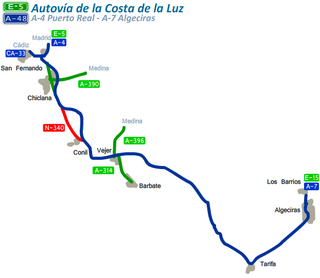
The Autovía A-48 is a highway in Andalucia, Spain.
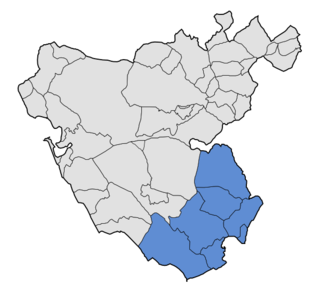
Campo de Gibraltar is a comarca (county) in the province of Cádiz, Spain, in the southwestern part of the autonomous community of Andalusia, the southernmost part of mainland Europe. It comprises the municipalities of Algeciras, La Línea de la Concepción, San Roque, Los Barrios, Castellar de la Frontera, Jimena de la Frontera and Tarifa.
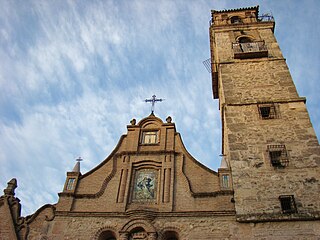
Alameda is a town and municipality in the province of Málaga, part of the autonomous community of Andalusia in southern Spain. The municipality is situated approximately 85 km from the city of Málaga. It has a population of approximately 5,000 and the natives are called Alamedanos or Lametanos. It takes its name from the stream Álamos, which crosses the municipality. The Bandito "El Tempranillo" is buried here.

El Estrecho Natural Park is a natural park in Spain, located on the northern side of the Strait of Gibraltar.

The Chapel of Our Lady of Europe is a Roman Catholic chapel located in the High Square of Algeciras (Spain). The popularly known "Capillita de Europa" is considered as the foundational element of the modern city of Algeciras. It was the host of the statue of the Virgin and the Child kept in the Shrine of Our Lady of Europe from the capture of Gibraltar by the Anglo-Dutch fleet in 1704 to 1864.

Fuerte de Isla Verde was a military installation formerly located in Algeciras, Spain. It occupied the Isla Verde, which gave its name to the city as a whole. The elongated island, which stood a short distance offshore of the city's old town, was already the site of an artillery battery in 1720. In 1734 the fort was constructed on the island to the plans of the military engineer Juan de Subreville. Further remodeling took place in 1745 under Lorenzo de Solís. The installation, which followed the roughly triangular shape of the island, was initially equipped with three batteries. These were:

Hotel Sevilla is a historic hotel in Algeciras, Spain. Its construction took place between 1922 and 1925 by the Madrid-based architect Emilio Antón. It is built in the neo-baroque style, with four floors. The balconies and balusters contain decorative floral motifs.

The Chapel of the Charity (Spanish: Capilla de la Caridad is a Roman Catholic chapel in Villa Nueva, Algeciras, Spain.

Playa de El Chinarral is a beach in the municipality of Algeciras, southeastern Spain. It overlooks the Bay of Algeciras and the tip of the rock of Gibraltar. It is approximately 250 metres in length and 40 metres wide on average. It is located between Punta de San Garcia and El Rodeo, south of the city.

Parque de las Acacias de Algeciras is a park in Algeciras, southeastern Spain. Established in 1975, it covers an area of 19,300 square metres (208,000 sq ft). The Museo municipal de Algeciras lies to the north and Villa Smith lies in the southern part of the park. The historic Hotel Reina Cristina overlooks the park on its western side.

Parque de la Conferencia is a park in Algeciras, southeastern Spain. Established in 2007 to mark the centenary of the Algeciras Conference. It covers an area of 9,011 square metres (96,990 sq ft) and is divided into several zones.

Algeciras Municipal Library is a public library network in Algeciras, Spain. Its headquarters are at the Biblioteca Cristóbal Delgado, located on Salvador Allende Street. There are two branches, including one in the Saladillo neighborhood, Biblioteca El Saladillo, and another in the La Granja neighborhood, Biblioteca Pérez Petinto. In addition to its book collection and reference materials, the institution offers a variety of cultural activities such as a book club. The library is run by the municipality. It was established in 1925 by the local historian Manuel Pérez-Petinto y Costa.
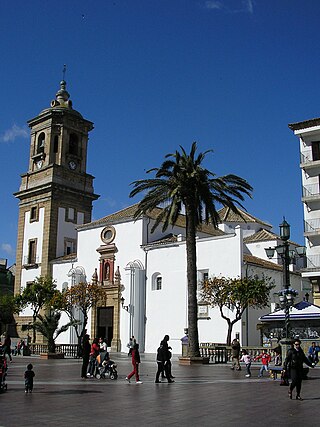
Plaza Alta is a square in the old town of Algeciras, Spain. It is one of the major centres of activity in the city, hosting numerous events and festivals throughout the year. Some of the city's most important buildings such as the Iglesia de la Palma and the Capilla de Europa stand on the square while neighbouring streets include Calle Ancha and Calle Convento.
El Pelayo or Pelayo is a village in the municipality of Algeciras in the Province of Cadiz in southeastern Spain, It is located 7 miles (11 km) southwest from the city centre, along the main road to the southern tip of Spain at Tarifa, which is 14 kilometres (8.7 mi) away. According to the National Statistics Institute, Pelayo had 867 inhabitants in 2010. Its economy is based on rural orchards and mills and it is one of the poorer areas of the municipality. The Guadiaro Palmones River flows in the vicinity and it is surrounded by trees and plants including ferns, oaks, alder, hornbeam, etc., and it is part of the Parque Natural de Los Alcornocales. Pelayo is along the bus route from Algeciras and Tarifa, with buses from the Transportes Generales Comes company.
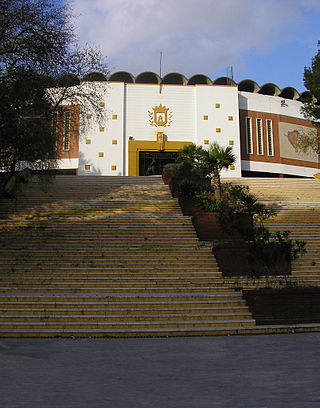
Plaza de toros de Las Palomas, officially Monumental Las Palomas, is a bullring in Algeciras at the southern end of Spain. The current building was built in 1969 and it can hold over 11,000 spectators.



















